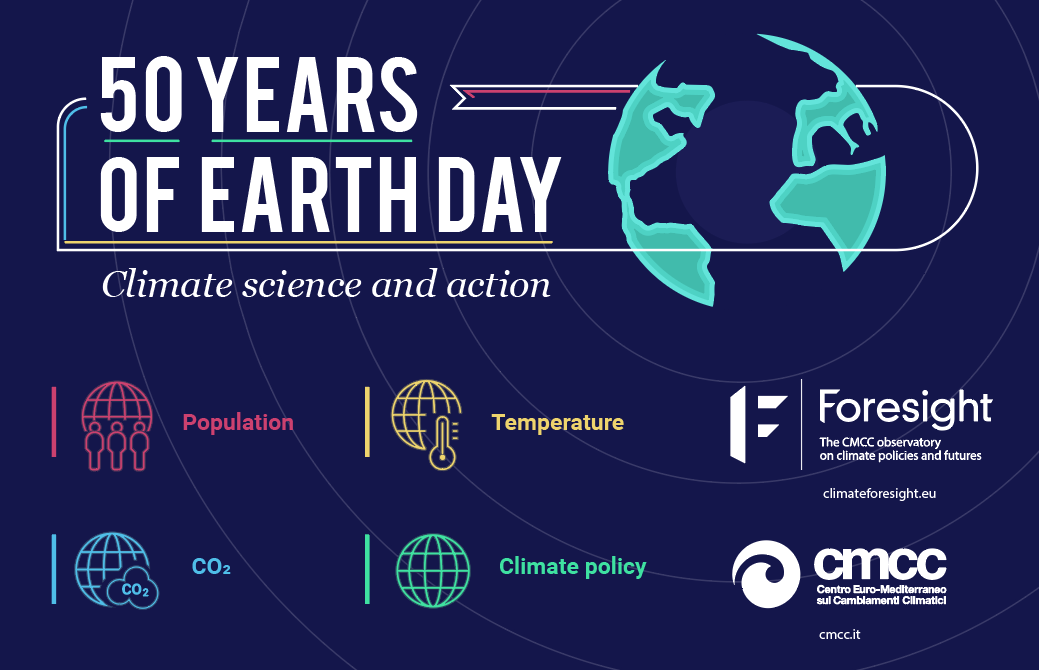Half a century in a timeline.
50 years of events, climate policy, actions and data about CO2, temperature, and population.
50 years that have brought science to the foreground of policymaking.
A selection of milestone moments to understand what has happened since 22 April 1970, when environmental concerns led 20 million Americans to take to the streets to demand more action by policymakers.
In 1970 environmental protection was beginning to make its way into mainstream political discourse following watershed events such as the publication of Rachel Carson’s book Silent Spring about the damaging effects of pesticide use. At the time, some of the most widely felt concerns revolved around issues such as high amounts of leaded gas in the atmosphere and the role of irresponsible industries in environmental degradation.
Half a century of Earth Day in a climate timeline
– CLICK TO SEE THE FULL TIMELINE –
On 22 April 1970, these concerns led 20 million Americans — a staggering 10% of the US population at the time — to take to the streets to demand more action by policymakers: this was the first-ever Earth Day, an idea launched by Senator Gaylord Nelson. In the wake of the protests, the US government passed the Clean Air, Clean Water and Endangered Species Acts, and the mobilisation also led to the creation of the Environmental Protection Agency (EPA).
From the environmental to the climate crisis
At the first UN Conference on the Human Environment in Stockholm in 1972, negotiators concentrated on chemical pollution, atomic bomb testing and whaling, whilst the signing of the Montreal Protocol in 1987 sought to regulate chemicals that were damaging the ozone layer. In this first phase of modern international environmental negotiations, civil society and policymakers focused on a wide range of environmental issues, without placing too much emphasis on the climate.
However, as awareness of the effects of human activity on natural systems grew, so did scientific research into climate change, which, in time has increasingly come to be perceived as the make or break issue of our time. The establishment of the Intergovernmental Panel on Climate Change (IPCC) in 1988, was a testament to how climate issues had come to the forefront of the international agenda. This focus grew throughout the 1990s with the establishment of the United Nations Framework Convention on Climate Change (UNFCCC) in 1994 and Conference of the Parties (COP) annual meetings starting in Berlin the following year.
The IPCC Second Assessment Report published at COP1 established that there is “a discernible human influence” on the Earth’s climate: an explicit reference to the anthropogenic origins of global warming which is remembered as a watershed moment in establishing the leading role of climate science in informing negotiations. In fact, the role of science in determining climate action was consolidated at COP13, in which parties agreed on the Bali Road Map.
Concurrently, civil society awareness and mobilisation was also moving forward. By 1990, Earth Day had become no longer just an American but a global event. That year, 200 million people in 140 countries took to the streets to join the initiative.
The data is clear
Foresight’s timeline outlines the trajectory of two data based climate indicators – average global CO2 levels and average global temperature rises relative to the 1951-1980 period – over the last 50 years. This offers an objective point of comparison against which to track the evolution of climate action and climate science over the same time period.
As scientists continue to monitor the environment, make data widely available to policymakers, and provide climate scenario to understand the impact of climate change in the years to come. It has become increasingly clear that climate diplomacy has not been effective enough in tackling the underlying causes of global warming. At the COP21 held in Paris in 2015, virtually all nations agreed to submit Nationally Determined Contributions (NDCs) aimed at maintaining global average temperature rise to below 2°C compared to pre-industrial levels. However, the scientific community warns us that current pledges would cause the planet to warm over 3°C, indicating that more ambitious goals need to be set.
Climate action must step up
The COP25 held in Madrid last year to deliver ambitious climate goals and create consensus around Article 6 of the Paris Agreement is just the latest example. A missed opportunity that could potentially be aggravated by the postponement of COP26 in Glasgow due to the Covid-19 pandemic.
2020 is a key year for climate negotiations, as countries are required to present their revised NDCs. In this scenario, civil society has played an important role in keeping the pressure on policymakers up. Movements such as Extinction Rebellion and Fridays for Future are increasingly using nonviolent protests and civil disobedience to demand that science dictate environmental policy so as to avoid tipping the balance of climate change and biodiversity loss completely out of control, and to avert the risk of social and ecological collapse. In this context, Earth Day remains an important avenue for such concerns to be voiced.
For this reason, it should come as no surprise that the theme chosen for the event’s 50th anniversary is climate action, shining the spotlight on the immense challenges, as well as potential opportunities, that lie ahead.








